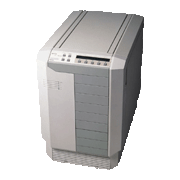Mitsubishi Electric announced the Apricot series of client-server computers in April 1991 as client-server systems to meet the growing trend toward distributed processing as more and more offices installed LANs. The series consisted of FT servers, Qi workstation clients, and LAN terminal clients. The description below applies to the FT servers.
Mitsubishi Electric used the latest PC technology to build the FT servers with the performance, capacity, and scalability servers need as well as with robust security and reliability.
- The servers were standard equipped with an Intel i486 32-bit high-performance CPU (25 MHz), 128 KB of external cache memory, and 4 MB of main memory. Main memory could be expanded up to 16 MB.
- The servers featured a 32-bit high-performance micro channel bus architecture (MCA) and seven expansion slots (four 32-bit slots and three 16-bit slots).
- The flagship model (M3507-A110) could house up to 5.2 GB of hard disk capacity. Access speeds were increased substantially with the provision of a 240 KB high-speed disk cache.
- Mitsubishi Electric furnished the servers with a total security system, including infrared security cards for access control.
- The servers were standard equipped with an uninterruptable power-supply unit that could power the server for up to 30 minutes in the event of a power outage. Extra reliability was added with redundant disk controllers for highly reliable disk operation.
- As an option, the servers could be fitted with a streaming tape backup system with up to 1.2 GB capacity, which simplified backing up even the largest hard-drive configuration.
- The servers ran NetWare or LAN Manager, which were well-regarded, standard network operating systems.
The top-end models of the series, the DS/90 7800E and 7900E, were announced in May 1995.
| Model name | Apricot FT486-25S Server | ||||
|---|---|---|---|---|---|
| Type name | M3507-A103 | M3507-A106 | M3507-A110 | ||
| CPU | Intel i486 32-bit microprocessor (25 MHz) | ||||
| Memory | Cache memory | 128 KB (external cache) standard, 8 KB (processor cache) | |||
| ROM | 128 KB (system ROM) | ||||
| RAM | 4 MB (expandable to 16 MB) | ||||
| Video RAM | 512 KB | ||||
| Storage memory devices | Floppy drive | One 3.5-inch drive (1.44 MB) | |||
| Hard disks | Capacity | 347 MB (max. 4,535 MB) | 647 MB (max. 4,835 MB) | 1,047 MB (max. 5,235 MB) | |
| Access time | 14.5 ms | 16.5 ms | 15.0 ms | ||
| Disk cache | 45 KB | 45 KB | 240 KB | ||
| Controllers | Max. two (SCSI interface) | ||||
| Internal streaming tape unit | 1.2 GB, 320/525 MB, 150 MB (all are optional) | ||||
| Interfaces | RS-232C | One channel, standard (D-sub 25 pin, ASYNC) | |||
| Printer | One channel, standard (Centronics, D-sub 25 pin) | ||||
| Mouse | One channel standard | ||||
| LAN | Ethernet or Token Ring (both are optional) | ||||
| Expansion slots | Seven slots (four 32-bit slots, two 16-bit slots, one 16-bit video slot) MCA bus | ||||
| Uninterruptable power-supply unit | Standard (30 minute max. of battery backup time) | ||||
| Security system | Standard (max. 100 registered users per unit) | ||||
| System panel | Power indicator, two disk operation indicators, control panel | ||||
| Speakers | Yes | ||||
| Calendar function | Year, month, date, hour, minute, second (battery backup) | ||||
| Standard rating | VCCI Type 1 | ||||
| Other details | Power supply | AC100VAC±10%,50/60Hz | |||
| Power consumption | 990VA | ||||
| Radiated heat | 800 J/second (688 kcal/hour) | ||||
| Operating conditions | Temperature:5-35℃,humidity:20-80%RH (below the point where condensation forms) | ||||
| Dimensions [mm] | 410 x 625 x 625 (w x d x h) | ||||
| Weight | 65kg | ||||


